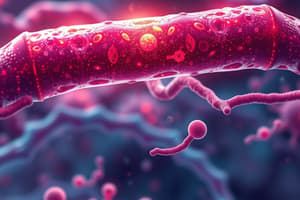Podcast
Questions and Answers
What condition is associated with mutations in the GLUT2 gene?
What condition is associated with mutations in the GLUT2 gene?
- Maturity Onset Diabetes of the Young
- Type I diabetes
- Hypoglycemic Shock
- Fanconi-Bickel Syndrome (correct)
What primarily triggers the translocation of GLUT4 to the plasma membrane?
What primarily triggers the translocation of GLUT4 to the plasma membrane?
- Exercise-induced signaling
- Low oxygen levels
- Insulin binding to its receptor (correct)
- Increased glucose concentration
What is the role of GLUT4 in the body?
What is the role of GLUT4 in the body?
- To transport fatty acids
- To regulate cholesterol levels
- To mediate protein synthesis
- To facilitate insulin-mediated glucose uptake (correct)
What effect does inhibition of GLUT4 have on insulin sensitivity?
What effect does inhibition of GLUT4 have on insulin sensitivity?
Which of the following cell types does NOT prominently express GLUT4?
Which of the following cell types does NOT prominently express GLUT4?
What is the initial substrate for the synthesis of cortisol?
What is the initial substrate for the synthesis of cortisol?
In which cellular organelle does the conversion of pregnenolone to progesterone occur?
In which cellular organelle does the conversion of pregnenolone to progesterone occur?
What role does cortisol play in gluconeogenesis?
What role does cortisol play in gluconeogenesis?
What is the final product produced from 11-deoxycortisol in the mitochondria?
What is the final product produced from 11-deoxycortisol in the mitochondria?
Which cycle describes the conversion of lactate formed by skeletal muscle into glucose in the liver?
Which cycle describes the conversion of lactate formed by skeletal muscle into glucose in the liver?
What regulates glycolysis and gluconeogenesis allosterically?
What regulates glycolysis and gluconeogenesis allosterically?
Which glucose transporter is sensitive to insulin?
Which glucose transporter is sensitive to insulin?
Where are high-capacity, bidirectional glucose transporters predominantly expressed?
Where are high-capacity, bidirectional glucose transporters predominantly expressed?
What is the only regulatory step in the pentose phosphate pathway?
What is the only regulatory step in the pentose phosphate pathway?
Which of the following is a genetic deficiency that leads to hemolytic anemia?
Which of the following is a genetic deficiency that leads to hemolytic anemia?
What differentiates galactosemia from lactose intolerance?
What differentiates galactosemia from lactose intolerance?
Which genetic deficiency is associated with hypoglycemia in premature infants?
Which genetic deficiency is associated with hypoglycemia in premature infants?
What is the normal fasting glucose level range for healthy adults?
What is the normal fasting glucose level range for healthy adults?
Which HbA1c level indicates poor glycemic control?
Which HbA1c level indicates poor glycemic control?
What is the post-prandial glucose level range indicating diabetes?
What is the post-prandial glucose level range indicating diabetes?
Flashcards are hidden until you start studying
Study Notes
Fanconi-Bickel Syndrome
- Caused by mutations in the GLUT2 gene, resulting in a rare autosomal-recessive disorder.
- Resembles type I glycogen storage disease.
GLUT4 Transporter
- Primarily found in adipocytes, skeletal muscle, and cardiomyocytes.
- Functions as an insulin-responsive glucose transporter, crucial for glucose homeostasis.
- Inhibition leads to acute peripheral insulin resistance.
- Responds to insulin binding through exocytosis, facilitating glucose uptake by mobilizing transporters to the plasma membrane.
Cortisol and Gluconeogenesis
- Cortisol synthesized in mitochondria from cholesterol via pregnenolone and subsequent conversions.
- Plays a role in increasing gluconeogenesis by activating PEPCK (P-EnolPyruvate Carboxykinase) upon binding to glucocorticoid-responsive genes.
- Essential for elevating hepatic glucose production.
Cori Cycle
- Lactate produced by contracting skeletal muscles during intense exercise is converted back to glucose in the liver.
- Liver returns glucose to muscles for glycolytic breakdown, supporting ATP production.
Glycemia Values
- Fast and post-prandial glucose levels categorize states of hypoglycemia, normal glycemia, pre-diabetes, and diabetes.
- Normal fasting glucose: 80-100 mg/dl, post-prandial glucose < 140 mg/dl.
- Diabetes characterized by fasting glucose > 126 mg/dl and post-prandial glucose > 200 mg/dl.
Hemoglobin A1c (HbA1c)
- Used to diagnose and monitor diabetes, reflecting average blood glucose levels over time.
- Normal range is 4.4-5.6%; higher levels indicate poorer glycemic control due to non-enzymatic glycation.
Overview of Glucose Metabolism
- Includes pathways like glycogenolysis and glycogenesis, glycolysis, and gluconeogenesis.
- Key enzymatic actions occur in specific tissues, especially liver and kidneys for gluconeogenesis.
Gluconeogenesis
- Converts pyruvate to glucose primarily in the liver and renal cortex.
- Essential for maintaining blood glucose levels, particularly for tissues with low gluconeogenic activity (brain, skeletal muscle, heart).
Glucose-6-Phosphatase and Wernicke-Korsakoff Syndrome
- Certain glycolytic reactions contribute to gluconeogenesis.
- Wernicke-Korsakoff syndrome linked to vitamin B1 deficiency and poor transketolase affinity, affecting carbohydrate metabolism.
Pentose Phosphate Pathway and Drug Hemolytic Anemia
- Source of NADPH in erythrocytes, vital for regenerating glutathione from its oxidized form (GSSG).
- Ratio of GSH to GSSG typically ranges from 100-1000 in normal cells.
- Glutathione reductase catalyzes reduction of GSSG to GSH using NADPH.
Glutathione's Role
- GSH helps detoxify hydrogen peroxide in erythrocytes, with glutathione peroxidase required for this reaction, dependent on selenium as a cofactor.
Studying That Suits You
Use AI to generate personalized quizzes and flashcards to suit your learning preferences.




